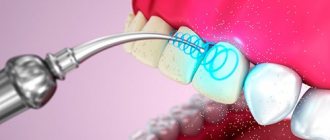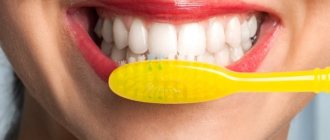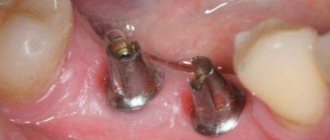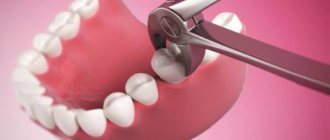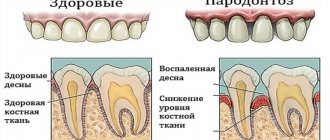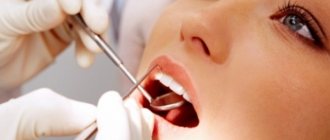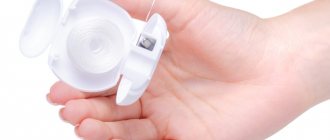5572
Cleaning the enamel of plaque and hard deposits, called tartar, is the basis for the prevention of most dental diseases.
In most cases, the usual hygiene procedures using a brush and paste at home are not enough, so it is recommended to carry out professional cleaning from time to time. One method is ultrasonic cleaning.
Despite the undoubted advantages of this technique, it, like many other medical procedures, has a number of contraindications.
For most people, ultrasound exposure to teeth is completely safe and even beneficial.
, however, some categories of patients should not resort to using ultrasound units with scalers - special tips.
How the procedure is carried out is briefly explained in the following video:
Definition
Teeth cleaning with ultrasound is carried out using a special device that generates ultrasonic waves with a high vibration frequency. This equipment does not injure the enamel due to the ability to regulate the frequency from 20 to 50 kHz.
The oscillatory movements of the wave help to loosen soft and hard plaque, which is then easily washed off with water.
Photos of the procedure results
Target
Most in-office crown cleaning methods are aimed only at removing soft deposits. Only a few of them are able to cope with tartar, but there is still a high probability of damage to the enamel.
Ultrasonic cleaning does not damage the surface of crowns and is aimed at solving several problems at once:
- removal of hard deposits, both on the visible part of the crown and in the area of periodontal pockets under the gum line;
- removing soft plaque;
- elimination of the pigmented layer , which leads to lightening of the crowns.
Thanks to high-quality removal of deposits, the risk of developing periodontal diseases and dental caries is minimized.
During pregnancy
The answer to this question is clear – it is not only possible, but also necessary. The pregnancy of a completely healthy woman does not indicate a ban on such procedures. Why is ultrasonic teeth cleaning necessary for expectant mothers during this period?
Dental diseases
If a pregnant woman's mouth does not receive proper care, caries may begin to develop. This is also facilitated by a lack of phosphorus, calcium and silicon in expectant mothers. Ultrasonic cleaning is a completely safe procedure that prevents the occurrence of such diseases and reduces the risk of their development to zero.
Gum condition
During pregnancy, women's gums weaken. They become softer, more loose. In the process of eating food, pieces of food become deeply clogged, thereby promoting the growth of bacteria.
It is almost impossible to clean these pieces with a regular brush, so it is best to use the services of a dentist for ultrasonic teeth cleaning.
Fetal development
Experts have proven that the condition of the oral cavity greatly affects the development of the fetus. To ensure proper development of the child, you need to carefully monitor oral hygiene. Ultrasonic cleaning is the best assistant in this matter.
Note! Experts say that this procedure cannot be performed in the last trimester of pregnancy. The best time is the second trimester.
After this procedure, the dentist will tell you in detail about proper oral care. This applies not only to pregnant women, but also to all other patients.
We suggest you read about how to use dental floss in our next article. In this review we will talk about how to choose the right electric toothbrush.
Here: https://dentist-pro.ru/krasota-i-uxod/sredstva/opolaskivateli/glister-ot-amvej-universalnoe.html instructions for using Glister mouth rinse are given.
The doctor will ask the following questions:
- special diet that temporarily excludes the consumption of coloring foods;
- hygiene , which after cleaning should be more thorough;
- using toothpicks .
Advantages and disadvantages
Compared to other methods of cleaning the teeth, ultrasonic cleaning has its own advantages and disadvantages.
The main advantages include the following:
- Safety for enamel. The ultrasonic cleaning system is designed in such a way that it does not directly affect the surface of the teeth. This significantly reduces the likelihood of damage.
- Quality of cleansing . Ultrasound is capable of breaking down hard deposits even under the gum, which is beyond the capabilities of most other methods.
- Simultaneously with cleansing of plaque, teeth are gently whitened to their natural tone.
- This procedure allows you to immediately assess the condition of tissues that were covered with hard deposits and notice their pathological changes.
- This procedure takes a short period of time and does not require special preparation.
- Cleansing is painless. In case of a large amount of deposits in the gum line area, topical or local anesthesia can be used, with a minimal dosage of anesthetics.
- This technique can be combined with other methods of professional crown cleaning.
- The procedure has an acceptable cost.
The disadvantages of this system include:
- Often, when cleaning, it is necessary to resort to curettage of periodontal pockets, which is carried out using a special attachment. In some cases, this leads to slight gum bleeding, swelling and redness;
- the quality of work and integrity of the enamel will directly depend on the professionalism of the dentist , since the cleansing procedure involves direct exposure of the tip of the ultrasonic device to deposits;
- The precision of the impact will depend on the type of device . If outdated models are used, where ultrasound is delivered elliptically, then the likelihood of injury to periodontal tissue and crowns increases.
Effective teeth whitening with the Zoom system: reviews, prices, description.
How to whiten teeth at home? Here are tips on how to carry out the procedure using folk remedies.
Follow the link https://zubovv.ru/krasota-i-uxod/otbelivanie/domashnee/otzyivyi-pro-perekisyu-vodoroda.html recipe for teeth whitening with hydrogen peroxide.
Pros and cons of ultrasonic teeth cleaning
The method of removing stones using ultrasound has the following advantages:
- does not take much time (about an hour on average) and does not require special preparation;
- causes minimal discomfort to the patient; in difficult cases, it is performed under local anesthesia;
- removes tartar with maximum effect;
- removes tartar under the gums;
- immediately after ultrasonic cleaning, a feeling of freshness appears in the oral cavity;
- prepares teeth for further treatment;
- the color of the enamel becomes noticeably lighter due to the removal of pigmented plaque;
- the structure of tooth enamel is not subject to mechanical damage and becomes stronger;
- ultrasonic teeth cleaning - effective prevention of caries and other dental diseases;
- affordable prices.
Despite such a long list of advantages, ultrasonic teeth cleaning has some disadvantages. Disadvantages include:
- the presence of a number of contraindications;
- in some cases, removing tartar from all sides is impossible;
- if the patient has sensitive teeth, local anesthesia is required;
- possible mechanical injury to the soft tissues of the oral cavity.
When the procedure is prohibited
This method can only be used if the patient does not have the following contraindications:
- The presence of a device for artificially maintaining heart rhythm or other implanted stimulating devices.
Unfortunately, the effects of ultrasound waves are not limited to the oral cavity. Vibration can be transmitted throughout the body and lead to malfunction of the stimulating device or its breakdown. - Pathologically high sensitivity of enamel . The impact of waves is aimed not only at surface cleansing, but also at removing pigments and bacteria from enamel micropores, which can cause the situation to worsen.
- Pregnancy .
Studies have shown that an ultrasonic wave, even of low frequency and power, can cause changes in the metabolic processes of a woman’s body, which directly affects the development of the fetus. The body perceives this effect especially acutely in the first trimester of pregnancy. In other months, this procedure is allowed if there are no general pathologies. - Period of mixed dentition .
At this time, such cleansing is not recommended because children's tooth enamel is too thin. The service can only be used 2 years after the eruption of the last tooth. It is during this time that the enamel will reach the required density and thickness. - Heart diseases. Exposure to ultrasonic waves may cause short-term rhythm disturbances.
- Chronic bronchitis or bronchial asthma. The device is able to influence the functioning of blood vessels, leading to their narrowing and spasm. In the presence of these diseases, this can lead to an attack of suffocation.
- Respiratory infections. Since cleaning causes injury to dental and periodontal tissues, infection can settle in the wounds and cause inflammation.
Look at the photos before and after laser teeth whitening. And also patient reviews.
This article contains instructions with photographs of movements on how to use dental floss.
Here https://zubovv.ru/krasota-i-uxod/otbelivanie/professionalnoe/chto-takoe-po-sisteme-amazing-white.html reviews about Amazing White whitening.
Relative
Despite the safety of the ultrasonic cleaning procedure, its implementation has a significant list of contraindications. Some of them can be eliminated with certain treatments, but there are a number of reasons why patients will have to choose a different method of plaque removal.
Relative contraindications include patient conditions in which the procedure is undesirable, but can be performed with the permission of the attending physician or after eliminating pathologies that do not allow the procedure.
Relative contraindications to ultrasonic teeth cleaning:
- The presence of acute respiratory viral infections . A weakened immune system of the body during colds can lead to infection of periodontal tissues in the presence of damaged areas.
- Inflammatory processes on the oral mucosa. Ultrasonic vibrations produced by the device increase bleeding and swelling of the gums.
- Diabetes mellitus in the acute phase. During this period, there is a possibility of injury to the gums and mucous membranes of the oral cavity, which will last for a long time. Therefore, in order to prevent the risk of complications, ultrasonic teeth cleaning should be postponed until the glucose level returns to normal.
- Neoplasms in the oral cavity . Exposure to ultrasonic vibrations can lead to rapid growth of tumor cells and the possibility of their modification.
- Stomatitis. Additional intervention during the course of the disease contributes to the formation of new aphthae and the transition of stomatitis to the chronic stage of its course.
- High sensitivity of enamel. Ultrasonic waves help not only remove plaque from the enamel surface, but also eliminate pigmented areas and pathogenic microorganisms from the pores. This can lead to increased soreness and sensitivity to temperatures.
- Undergoing immunosuppressive therapy using corticosteroid and immunosuppressive drugs.
What care is needed for implants after installation at home and in dentistry. Read in this article which foods that stain teeth enamel should be consumed with caution.
Follow the link https://dr-zubov.ru/krasota-i-uxod/sredstva/zubnye-pasty/chudodejstvennye-iz-tailanda-pravda-i-mify.html to find out reviews about toothpastes from Thailand.
Operating principle
For removal, a special ergonomically designed device is used. An ultrasonic generator is built into its body , supplying an adjustable frequency wave to the tip. For ease of operation and quality of cleaning, the nozzles of the cleaning handle of the device can be changed.
The procedure provides a classic set of tips designed for:
- cleansing the visible part of the crown from soft deposits;
- dental treatment before prosthetics ;
- removal of deposits in the area of periodontal pockets ;
- surface polishing;
- removal of tartar.
In addition to a wide selection of attachments, different operating modes are used. Cleansing can be carried out either using the dry method or using liquids . This makes it possible to use not only ordinary water, but also various aseptic and anti-inflammatory agents.
Effective removal of deposits occurs due to a double action:
- The wave is supplied with a pulse frequency , due to which the tip has an oscillatory effect on the deposits and destroys them mechanically.
In order to avoid damage to dental tissue, it is necessary that the movements of the scaler be linear along the entire surface of the tooth. - The simultaneous supply of ultrasound and water leads to the effect of cavitation - the formation of many microbubbles, which loosen plaque and promote its separation from the enamel.
All scalers are equipped with special lighting, which improves the quality of cleaning.
Methodology
The ultrasonic cleaning procedure begins with an examination, during which the dentist determines the volume of deposits and the quality of oral hygiene. If necessary, the patient is given local anesthesia.
Further, cleansing takes place in several stages:
- Cleaning the visible part of the crowns from soft deposits.
- Removing tartar along the gum line .
- Curettage of periodontal pockets.
- In order to remove deposits located deep in the pores of the enamel, ultrasonic cleaning the Air-Flow teeth cleaning system
- Then they begin to level the dental surface using a special micro-abrasive paste and a grinding attachment.
- Finally, the crowns are coated with fluoride to strengthen the enamel.
In this video, a specialist talks about the procedure:
How is ultrasonic teeth cleaning performed?
During the examination, the dentist assesses the condition of the teeth in general, the volume and places of accumulation of hard deposits. Some can be located on the visible part of the teeth and under the gums, while others can only be identified using special equipment. If deep cleaning is required, or the patient has increased sensitivity of tooth enamel, then local anesthesia is used.
The procedure is carried out with an ultrasonic scaler and includes several stages:
- cleaning the visible part of the teeth;
- removing stone along the gums;
- cleaning pockets under the gums;
- grinding the surface of teeth with professional micro-abrasive pastes and attachments to eliminate roughness from destroyed formations; polishing makes the tooth surface smoother and makes it more difficult for plaque to accumulate on the teeth;
- To strengthen the enamel, your dentist may recommend a fluoride coating. Fluoridation after ultrasonic cleansing gives the maximum effect, as the absorbency of the enamel increases.
Different modes of operation of the device make it possible to carry out cleansing using liquids or the dry method. The liquid may be water or, if necessary, the dentist may recommend anti-inflammatory agents or antiseptics. The simultaneous supply of ultrasonic vibrations and liquid causes the appearance of microscopic bubbles, which help soften and separate hard dental deposits from the enamel.
Care
In order for the effect of whiteness and cleanliness of teeth to last as long as possible, it is necessary to adhere to standard rules of oral hygiene:
- You should not abuse coloring and carbohydrate products, which lead to the appearance of bacterial deposits and enamel pigmentation.
- The main rule is high-quality cleaning of crowns . To do this, you need to use more than just a regular brush. It is necessary to additionally use floss, brushes and rinses. It is also recommended to use an irrigator regularly.
- You should not avoid regular visits to the dentist , who can promptly detect dental diseases at the initial stage of their development.
The benefits and harms of professional teeth cleaning
Rice. 1. Hard plaque.
Plaque can be soft or hard. Calcified plaque is also called tartar. Tartar and plaque can be located above the gum and below the gum. Supragingival tartar is usually lighter, subgingival tartar is darker.
Rice. 2. Tartar.
Soft dental deposits can be removed independently by effective cleaning with a regular toothbrush. A rotating electric brush can partially remove hard supragingival plaque. It can be completely removed, as well as tartar, only in the dentist's chair. This procedure is called professional oral hygiene.
Rice. 3. Soft plaque.
Previously, cleaning was carried out using hand excavators and Gracie curettes. Since the end of the 20th century, this method began to gradually give way to ultrasonic and air-abrasive processing (AirFlow). Air abrasive treatment can only remove supragingival plaque. It is difficult for AirFlow to remove supragingival tartar; it is better to use ultrasound in this case. Ultrasound removes any type of dental plaque, but it is not recommended to remove supragingival plaque, as this can lead to enamel cracks. Therefore, the best hygienic cleaning option is a combination of these two options.
Rice. 4. Tip for air-abrasive processing Airflow (EMS, Switzerland).
Price
The cost of this procedure is quite acceptable and is in the range of 1000–3000 rubles . On average, processing one tooth costs 50 or 70 rubles.
But increasingly, dentists offer a professional cleaning procedure, where ultrasonic treatment is only part of it. As a rule, it is complemented by treatment with the Air Flow system and fluoridation of the crowns. Such a complex can cost 4,500 rubles or more, depending on the status of the clinic.
Reviews
Nowadays, a large number of clinic patients resort to ultrasonic cleansing. Their reviews indicate the effectiveness and safety of this procedure. Only a few report slight discomfort that goes away on its own within a few days.
We invite you to share your opinion about this service in the comments to this article.
If you find an error, please select a piece of text and press Ctrl+Enter.
Tags professional cleaning ultrasonic cleaning
Did you like the article? stay tuned
